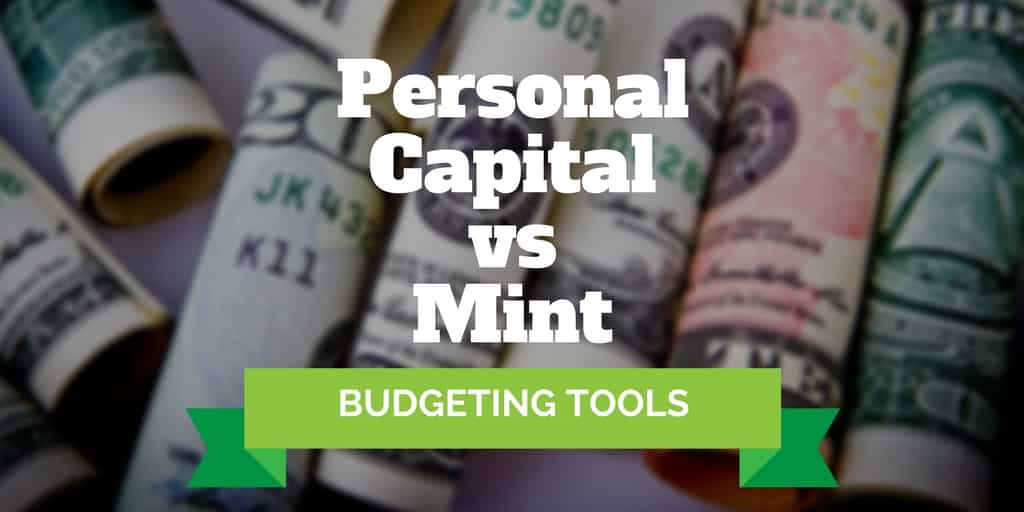

If you struggle to keep track of your personal finances, Personal Capital and Mint can help you. Both are free so when comparing Personal Capital vs Mint, which should you choose?
Mint is primarily designed as a budgeting tool that can help you to monitor your income and expenses, set spending goals, and pay off debt.
Personal Capital can also help you to track where you money is going each month, whether to groceries, gas, rent, or entertainment. But where it shines brightest is in tracking your investments.
Both the Personal Capital app and Mint are free, so when comparing Personal Capital vs Mint on security, synchronization, budgeting, investment analysis, and more, which is the best personal finance tool?
Personal Capital vs Mint


Whether you have bank or investment accounts, credit cards, or loans, Mint and Personal Capital can help keep track of your transactions.
You can easily track your overall net worth and where your money is being spent, so you can quickly spot when you spend more than normal in a particular category..
But how are Personal Capital and Mint different from each other?
Is Personal Capital or Mint Better?
One way Personal Capital and Mint diverge is how they make money.
Personal Capital earns revenues when you invest money in its robo-advisor service that includes access to a dedicated financial advisor. Mint, on the other hand, makes money from serving you ads to relevant financial services.
If you simply want to keep track of transactions in your bank and loan accounts, as well as on your credit cards, Mint provides you both a snapshot view of your overall financial situation and allows you to delve deep into each specific payment and income item.
Mint is smart enough to know when you are paying more in interest than you could pay elsewhere, and will display offers to nudge you towards another financial product that may be a better fit to help you to save money.
If the nitty gritty of every transaction isn’t as important to you as tracking your investment accounts and receiving financial guidance from a real person then Personal Capital is a better bet.
In a nutshell, Mint wins more brownie points for budgeting while Personal Capital wins more for investment monitoring.
MINT VS PERSONAL CAPITAL
Mint has the edge over Personal Capital when it comes to perks like seeing your credit score, monitoring your credit report, and setting financial goals and budgets.
It also has an enhanced security protocol. Although Personal Capital does restrict access to its app when it doesn’t recognize the device you are signing in from, Mint provides superior security via two-factor authentication.
| Feature | Personal Capital | Mint |
| Free | ✅ | ✅ |
| Bill Pay | ❌ | ✅ |
| Financial Advisors | ✅ | ❌ |
| Two-factor Authentication | ❌ | ✅ |
| Financial Ads | ❌ | ✅ |
| Set Budget Goals | ❌ | ✅ |
| Monitor Net worth | ✅ | ✅ |
| Track Expenses | ✅ | ✅ |
| Track Income | ✅ | ✅ |
| Credit Report Monitoring | ❌ | ✅ |
| Free Credit Score (1 credit bureau) | ❌ | ✅ |
| Retirement Planner | ✅ | ❌ |
Some users find it annoying that Mint displays ads. But the financial ads are intended to be relevant and helpful finding ways to save you money.
For example, if you are paying a high interest rate on your credit card and Mint knows another credit card will save you money, it will let you know.
But Mint won’t do as good a job for you with investment analysis as it will with budget analysis.
Unlike Mint, Personal Capital can inform you when you have allocated more money to a particular category than might be appropriate. For example, you may have too much allocated to equities or too few bonds for your risk category, age, and investment outlook.
Or you might have a good balance of stocks and bonds but you may not be optimized for tax efficiency.
Smart investing means allocating tax-efficient investments to tax inefficient accounts and tax-inefficient investments to tax-efficient accounts.
Dedicated financial advisors at Personal Capital can help you to navigate tax-advantaged strategies and portfolio selections and weightings, whereas Mint will simply provide an overview of investment account balances and weightings.
Here's something investment expert Nilus Mattive has never discussed publicly before...
He believes right now is the best time to consider putting some money into the cryptocurrency markets. Let him show you the seven big cryptos that could go to zero, as well as some of his favorite plays and strategies for 2023.
Watch this free video and see for yourself.
Mint: Spotlight
| MINT SPOTLIGHT | |
 InvestorMint Rating 4.5 out of 5 stars |
via Mint secure site |
➤ Free Guide: 5 Ways To Automate Your Retirement
Personal Capital vs Mint: Features
Personal Capital and Mint both have excellent user experiences. It’s simple to sign up to each personal finance app whether on the web or on mobile devices, both Android and iOS.
Mint has a slightly broader geographic reach by supporting U.S. and Canadian financial institutions compared to Personal Capital that supports U.S. based ones only.
| Features | Personal Capital | Mint |
| User Experience | Excellent | Excellent |
| Account Synchronization | Excellent | Good |
| Customer Support | Excellent | Good |
| Tax Reporting | Excellent | Good |
| Geography | U.S.A. | U.S.A. & Canada |
| Web Access | ✅ | ✅ |
| Mobile Access | ✅ | ✅ |
One thing you should note before signing up to either service is how often each will contact you.
From our research, Personal Capital tends to contact clients every few months to pitch investment management services, and more frequently to provide financial reports.
It’s not particularly intrusive in our view, especially because it is the primary way the company makes money.
Mint contacts users more frequently to notify when account thresholds have been breached, unusual spending patterns have been detected, and to serve ads from time to time – but they do so also with the intention to add value by helping you to save money or lower your interest rate payments.
From our research, Personal Capital synchronizes better with financial accounts compared to Mint.
Personal Capital relies on the industry standard Yodlee to perform account synchronization whereas Mint uses its parent company’s (Intuit) synchronization service.
Personal Capital: Spotlight
| PERSONAL CAPITAL SPOTLIGHT | |
4.5 out of 5 stars |
via Personal Capital secure site |
The next 10 minutes could change your life. We've recorded a special sit-down interview with a reclusive millionaire who details how he's closed out winning trade after winning trade throughout the volatility of 2022. In fact, he hasn't closed a single losing trade since 2016. Sounds impossible? It's not - and he'll prove it to you.
Click to see this exclusive sit-down interview
Personal Capital vs Mint:
What You Need To Know
If you want a personal finance tool that anticipates upcoming expenses and flags unusual activity on your accounts, Mint is your best bet.
BILL PAYMENTS & NOTIFICATIONS
A standout feature that distinguishes Mint from Personal Capital is bill pay functionality.
If you ever were frustrated by having to log into various different accounts to pay utility bills, make loan payments, and pay monthly credit card bills then Mint will seem like bill pay nirvana.
It’s easy to log in to Mint and manage all your payments from one location.
Personal Capital will notify you when payments are due but it does not support bill payments that allow you to avoid logging in to multiple accounts.
GOAL SETTING
If you wish to set financial goals such as buying a home, saving for college, or building a nest-egg for retirement, Personal Capital is the ideal choice.
The Retirement Planner tool from Personal Capital helps you to answer the question: “can I retire yet?”
By projecting your portfolio value into the future, it can assess your readiness to retire using financial accounts you have linked.
The Personal Capital Retirement Planner tool can factor in earnings from savings and investments as well as social security and annuity income.
Plus, your expected costs in retirement are calculated so an overall estimate is calculated.
FINANCIAL TAX PLANNING
When it comes to long-term financial planning, Personal Capital does a better job because the focus is on tax-advantaged investing.
At the end of the day, what matters is how much money ends up in your pocket after taxes.
And at Personal Capital, you can see in a heartbeat whether you are on track to meet your retirement goals.
Mint pays more attention to day-to-day financial optimizations versus long-term retirement planning.
HUMAN ADVICE
If you have complicated financial circumstances, Personal Capital is the best solution to receive guidance from a real financial expert.
Although its financial app is a great budgeting tool, Personal Capital is primarily an investment management service.
The app is free but the management service comes at a cost of an annual management fee.
Depending on how much you invest, you will receive either one or two dedicated financial advisors.
So, if you feel like your financial accounts are a spaghetti mess of IRAs, 401(k)s, 529 Plans, plus a joint account and a trust alongside a taxable account, Personal Capital is well worth checking out.
DEBT & BUDGETING FOCUS
The combined student debt and credit card debt in the U.S. stretches into the trillions of dollars, so it’s no surprise that Mint has a heavy focus on paying off debt.
Mint will help you keep better track of budgeting also by allowing you to specify spending limits, which will trigger notifications if you exceed them.
For example, if you allocated $700 to groceries this month but ended up spending $1,000, you will receive a notification from Mint informing you of the overage.
Personal Capital features elegant charts that provide instant insight into where your biggest costs are but you don’t have the same control over setting spending limits for each category.
Personal Capital vs Mint:
Summary
Personal Capital and Mint are among the best personal finance apps available to web-based and mobile users.
They both cater to a U.S. audience though Mint also synchronizes with Canadian financial institutions.
When you compare Personal Capital vs Mint on budget overviews, they are hard to separate but Mint shines brightest when it comes to tracking individual expenses and setting limits that trigger notifications if exceeded while Personal Capital is a better bet for investment account monitoring.
Personal Capital also wins more brownie points for tax-advantaged investing and linking to dedicated financial advisors.
You will also receive red carpet service at Personal Capital in terms of customer care and access to dedicated financial advisors if you choose the paid investment service. The free service provides you access to top tier customer support staff.
Where Mint has the edge is in providing a two-factor authentication security protocol and flagging unusual account activity. But its synchronization doesn’t quite match that at Personal Capital.
The bottom line is Mint wins the battle of best budgeting tool, Personal Capital wins the head-to-head for best investment analysis tool.
While both apps earn high marks, Personal Capital edges out Mint because of its more complete service, catering to both users who want to budget smarter and manage investments better.
In times of inflation, gold prices have an inverse relationship with the markets, growing in value during market volatility. Amid economic instability, some retirement savers see precious metals, as an opportunity for profit and wealth preservation. Get the practical insights to take back control of your retirement with safe-haven assets like Gold & Silver.
Download the latest Global Gold Report, featured in Fortune Investors Guide.









Leave a Reply